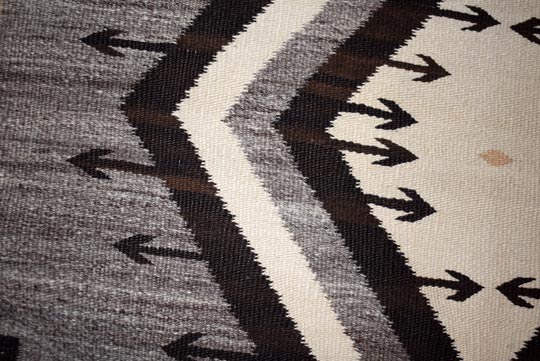Navajo Rug from Crystal Trading Post in Chuska Mountains
+ Add to my watchlist Forward to Friend
Forward to Friend
- Category: Navajo Textiles
- Origin: Diné of the Navajo Nation
- Medium: Wool
- Size: 5’9” x 3’9”
- Item # C4514C
- Price: $2760
This early twentieth century rug was woven in the area of Crystal Trading Post in the Chuska Mountains of New Mexico. The Chuska Mountain Range runs along the Arizona-New Mexico border and lies within Apache County in Arizona and McKinley and San Juan Counties in New Mexico. Crystal Trading Post is on one side of the mountain and Two Gray Hills on the other side. The famous former trader at Crystal was J. B. Moore, who departed there in 1911.
This Navajo floor rug from the first decades of the twentieth century was woven from the wool of a Churro sheep. It has the feeling of cashmere wool. The background is gray—carded from white and black wool—and the design is focused on two massive diamonds. If one reviews J. B. Moore's 1903 and 1911 mail order catalogs, one sees many of the illustrations featuring diamonds in the design.
Surrounding the two large diamonds we see arrows—some in black and some in white. There are step elements on the sides of the textile in colors of brown, white, and beige. The side borders repeat a brown and white arrowhead pattern.
This rug is typical of those made at Crystal Trading Post around 1910-1920. The Indian trader, J. B. Moore, was responsible for encouraging the weavers to make the finest textiles using the finest wool. He departed the trading post in 1911, but his weavers continued producing the finest of textiles as he had directed. Patterns eventually changed from his selected ones—slight changes in the early years and more drastic changes later.
J. B. Moore was a native of Sheridan, Wyoming. He bought an interest in the trading post at Washington Pass, N.M. in 1896, a remote and isolated area from a main commercial area. The post was there because there were many Navajo living in those mountains. There had been traders in the region from as early as 1878 but they mostly set up in tents in the summer and departed before winter. J. B. Moore bought out the remaining share of the post before the end of the year and named it Crystal Trading Post. He built a sturdy log post and house and freighted in enough supplies to last the winter. The elevation of Washington Pass is about 8,000 feet and there is a great deal of snow on the ground much of the year, making it impossible to freight in supplies, probably explaining why there had been a rapid succession of traders.
The remoteness of the Crystal area and the fact that winter business was limited led Moore to issue mail order catalogs, a newly developed American merchandising technique popularized by Sears, Roebuck, and Montgomery Ward.
One should not overlook Moore's respect for the women who wove his rugs. He is the first merchant to mention the women by name and even to show their pictures. In his personalization of Navajo weaving, Moore was far ahead of his time, for only in the last few decades have traders once again begun to identify their weavers by name, and to attach Polaroid photos to rugs they sell.
Moore was one of the great pioneers in the field of Navajo weaving and was instrumental in changing it from blankets to rugs. He, along with other traders of the late nineteenth and early twentieth centuries, saw that the future of weaving lay with adapting to the changes in Anglo taste, adaptations that are still being carried on by weavers and traders working together.
Condition: very good condition
Provenance: this Navajo Rug from Crystal Trading Post in Chuska Mountains is from a client from Colorado
Reference: J. B. Moore-United States Licensed Indian Trader, Avanyu Publishing, Inc., 1987.
TAGS: textiles, Navajo Nation

- Category: Navajo Textiles
- Origin: Diné of the Navajo Nation
- Medium: Wool
- Size: 5’9” x 3’9”
- Item # C4514C
- Price: $2760
Adobe Gallery Recommended Reading
Adobe Gallery Recommended Items
If you are interested in this item, we would also like to recommend these other related items:



